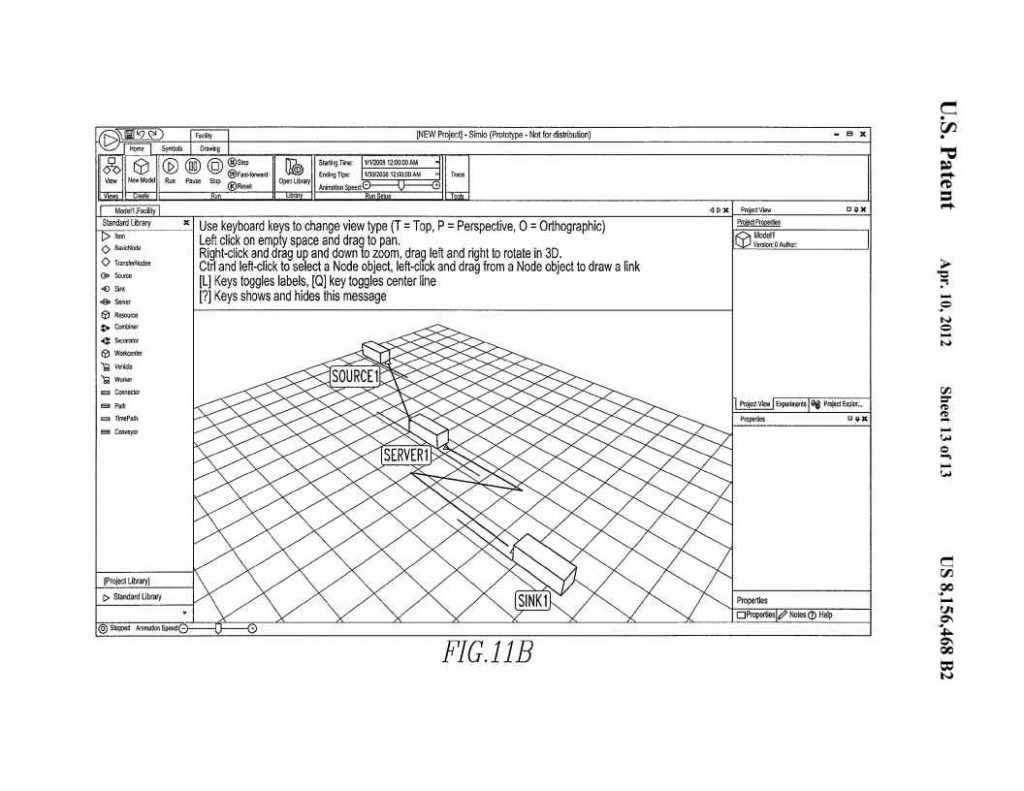SIMIO, LLC V FLEXSIM SOFTWARE PRODUCTS, INC, FEDERAL CIRCUIT 2020 (SOFTWARE PATENTS)

According to the Federal Circuit, simply applying the already-widespread practice of using graphics instead of programming to the environment of object-oriented simulations is no more than an abstract idea.
Simio, LLC sued FlexSim in District Court for infringing U.S. Patent No. 8,156,468. The district court found the patent to be ineligible for patenting under 35 U.S.C. § 101. Simio appealed.
The patent also describes a trend that emerged in the 1980s and 1990s: using graphics to simplify building simulations. The patent’s purported invention concerns making object-oriented simulation easier and more accessible by letting users build simulations with graphics instead of programming.
Claim 1 is the only independent claim and recites:
A computer-based system for developing simulation models on a physical computing device, the system comprising:
- one or more graphical processes;
- one or more base objects created from the one or more graphical processes,
- wherein a new object is created from a base object of the one or more base objects by a user by assigning the one or more graphical processes to the base object of the one or more base objects;
- wherein the new object is implemented in a 3-tier structure comprising:
- an object definition, wherein the object definition includes a behavior,
- one or more object instances related to the object definition, and
- one or more object realizations related to the one or more object instances;
- wherein the behavior of the object definition is shared by the one or more object instances and the one or more object realizations; and
- an executable process to add a new behavior directly to an object instance of the one or more object instances without changing the object definition and the added new behavior is executed only for that one instance of the object.
The district court applied the two-step framework set forth in Alice Corp. Pty. Ltd. v. CLS Bank International, and held the asserted claims ineligible.
At step one of Alice’s two-step framework, the courts are to determine whether the claim at issue is directed to an abstract idea. If so, we move to step two, where we “examine the elements of the claim to determine whether it contains an ‘inventive concept’ sufficient to ‘transform’ the claimed abstract idea into a patent-eligible application.
The patent showcases its key advance: using graphics instead of programming to create object-oriented simulations. Objects are built using the concepts of object-orientation. Unlike other object-oriented simulation systems, however, the process of building an object in the present invention is simple and completely graphical. There is no need to write programming code to create new objects.
Using graphical processes to simplify simulation building has been done since the 1980s and 1990s.
According to the Federal Circuit, simply applying the already-widespread practice of using graphics instead of programming to the environment of object-oriented simulations is no more than an abstract idea.
Simio argued that the claim “improves on the functionality of prior simulation systems through the use of graphical or process modeling flowcharts with no programming code required.” But, according to the Federal Circuit this argument did not explain how the computer’s functionality is improved beyond the inherent improvement of the experience of a user who cannot use programming.
Simio also argued that claim 1 improves a computer’s functionality “by employing a new way of customized simulation modeling with improved processing speed.” FlexSim responded, however, that this allegedly improved “processing speed” is not that of the computer; rather, it concerns only a user’s ability to build simulation models faster by using graphics instead of programming. The Federal Circuit agreed with FlexSim and rejected Simio’s argument because claiming the improved speed or efficiency inherent with applying the abstract idea on a computer is insufficient to render the claims patent eligible as an improvement to computer functionality.
The Federal Circuit also stated that that the nature of the claim here, read in light of the specification, confirmed that it was not directed to an actual technological improvement.
It is important, for patentability of software, to improve the hardware or at least the operation of the computer, as opposed to making things more efficient for the user.